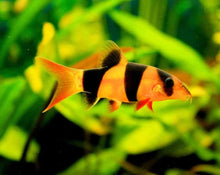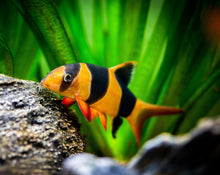Guaranteed Secured Checkout
The Clown Loach or Chromobotia macracanthus is a beautiful fish. If you've ever seen a school of clown loaches, it's hard to resist bringing a few of them home. It's even harder to imagine that this beautiful fish is eaten as food fish in Indonesia and Borneo, where it grows to over a foot in length. Fortunately for the clown loach, among aquarium enthusiasts, it's a staple in the community tank rather than on the dining table. Its orange and black striped body, red fins, and active behaviour made it one of the most popular loach species for aquarists. This has to be one of the most favourite fish species of the staff at Melbourne Tropical Fish. The clown loach is a peaceful fish and coexists well with nearly any tankmate. It is also an amusing species to watch and feed as it is very active during the day. Clown loaches will even eat any annoying snails that wind up in your aquarium. The clown loach is sometimes called a scaleless fish, but it actually does have small scales embedded in its skin.
Origin and Distribution
The clown loach hails from the rivers and tributaries of Malaysia, Borneo, Sumatra, and Kalimantan. During spawning periods, they migrate to flooded areas of the rainforest where soft, tea-coloured water flows through boggy, slow-moving streams. This loach prefers waterways that are shaded by leafy plants and lined with plant detritus such as fallen leaves, twigs, and branches.
Colours and Markings
Like all loaches, the clown loach has a long, pointed nose surrounded by sensitive whisker-like barbels and a sharp spine beneath each eye. These spines are used for defence; in captivity, these may prick fingers or snag on nets, so it's important to be careful when handling your loach.
The clown loach's arched body is long and lean, ideal for cutting through the water. True to its name, its body is bright orange to yellow, and its fins and tail are bright red. It has two wide black V-shaped stripes along the sides of its body and a third black stripe running vertically through its eye.
Tankmates
Peaceful with its own and other species, the clown loach prefers to have companions with which it will form a school. Virtually all non-aggressive fish are suitable as tankmates. Because they prefer to live in groups, it's wise to keep four or more in a tank. They don't like bright light, will hide among plants or rocks as well, and sleep in holes, caves, and other hiding places.
Clown Loach Habitat and Care
Clown loaches are large schooling fish, and they are quite active. You will need a large tank with plenty of space for your loaches to move around. At the same time, however, each and every loach should have several hiding spots available; loaches love enclosed spaces and will sometimes "hide" in caves, tubes, and other hidey-holes. Hiding places can be made of wood or rock; strong, sturdy plants are also a good addition.
Unlike many loach species that are only active at night, the clown loach can be active during the daytime although it's likely to be most lively in the early morning and after dark. To watch your loach at play during waking hours, consider installing a blue "moonlight" tube or another form of bluish lighting, which will encourage your fish to come out to hunt.
Water quality is critical for keeping clown loaches healthy. Take care to keep the water very clean, well-aerated, and warm. An efficient filtration system and frequent water changes are critical. Tank lighting should be subdued, and the substrate should be soft and sandy.
Loaches are particularly prone to Ich infections; watch them closely whenever new fish or plants are added to the tank. In the unfortunate event that an infection does occur, keep in mind that loaches, like catfish, are very sensitive to some medications. Often dosages must be cut in half to be safe. Read product information carefully before treating any loach.
Clown Loach Diet and Feeding
Clowns will accept a wide variety of dry and live foods, but their preference is for live foods, especially worms. You can even feed them on earthworms, as long as you harvest the worms from soil that hasn't been fertilised recently. Ideally, you should feed them several small meals throughout the day.
Short Summary of Clown Loach Fish
Clown loach fish (Chromobotia macracanthus) are popular freshwater aquarium species known for their vibrant colours and playful behaviour. These lively and social fish originate from Southeast Asia and prefer well-maintained, spacious tanks with hiding spots. They have distinctive orange-red bodies adorned with black stripes, making them a visually striking addition to any aquarium. Clown loaches are omnivorous and enjoy a lively diet and prepared foods. They are also known for their peaceful temperament but can become aggressive if overcrowded. Maintaining proper water parameters and providing companionship in a group of at least three is crucial for their well-being. Clown loaches have a lifespan of up to 20 years and require diligent care to thrive in captivity.



